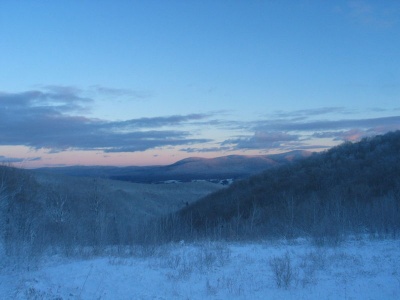The Berkshires: Difference between revisions
Nicesociety (talk | contribs) No edit summary |
Nicesociety (talk | contribs) |
||
| Line 2: | Line 2: | ||
==Geography== | ==Geography== | ||
[[Image:Berkshires in Winter.jpg|400px|right]] | |||
Geologically, the Berkshires are bordered on the west by the Taconic Mountains, the marble valleys of the Hoosic River and Housatonic River and, further south, by the Hudson Highlands; to the east, they are bordered by the Metacomet Ridge geology. They are on the average 1,000 ft (300 m) lower and less prominent than the Green Mountains of Vermont, and form a broad, dissected plateau punctuated by hills and peaks and cut by river valleys. The Berkshires topography gradually diminishes in profile and elevation from west to east and from north to south, except where rivers have cut deep gorges and sharp bluff faces into the Berkshire plateau. | Geologically, the Berkshires are bordered on the west by the Taconic Mountains, the marble valleys of the Hoosic River and Housatonic River and, further south, by the Hudson Highlands; to the east, they are bordered by the Metacomet Ridge geology. They are on the average 1,000 ft (300 m) lower and less prominent than the Green Mountains of Vermont, and form a broad, dissected plateau punctuated by hills and peaks and cut by river valleys. The Berkshires topography gradually diminishes in profile and elevation from west to east and from north to south, except where rivers have cut deep gorges and sharp bluff faces into the Berkshire plateau. | ||
Latest revision as of 22:28, 1 December 2008
The Berkshires, located in the western parts of Massachusetts and Connecticut, is both a specific highland geologic region and a broader associated cultural region. The region is also referred to as the Berkshire Hills, Berkshire Mountains, and, with regard to its physiography, Berkshire Plateau. Sir Francis Bernard, the Royal Governor, named the area "Berkshire," to honor his home county in England. Tourism is a principal industry, relying heavily on cultural art attractions and recreation.
Geography[edit]
Geologically, the Berkshires are bordered on the west by the Taconic Mountains, the marble valleys of the Hoosic River and Housatonic River and, further south, by the Hudson Highlands; to the east, they are bordered by the Metacomet Ridge geology. They are on the average 1,000 ft (300 m) lower and less prominent than the Green Mountains of Vermont, and form a broad, dissected plateau punctuated by hills and peaks and cut by river valleys. The Berkshires topography gradually diminishes in profile and elevation from west to east and from north to south, except where rivers have cut deep gorges and sharp bluff faces into the Berkshire plateau.
The highest point in the Berkshires geology is Crum Hill, 2,841 feet (866 m) of Monroe, Massachusetts; however, Mount Greylock of the Taconic Mountains, 3,491 ft (1,064 m), the highest point in the state of Massachusetts, is considered the high point of the Berkshires cultural region. The average regional elevation of the Berkshires ranges from about 700 to 1,200 feet (213 to 365 meters). The Berkshires and related Green Mountains were formed over half a billion years ago when Africa collided with North America, pushing up the Appalachian Mountains and forming the bedrock of the Berkshires. Erosion over hundreds of millions of years wore these mountains down to the hills that we see today.
The Housatonic River, Hoosic River, Westfield River, and Deerfield River watersheds drain the Berkshires region in Massachusetts; in Connecticut the main river drainages are the Farmington River, the Naugatuck River, the Shepaug River, and the Housatonic River.
The largest municipalities associated with the Berkshires cultural region include Pittsfield, North Adams, Adams, Great Barrington, and Williamstown, Massachusetts; and Winsted, Connecticut.
